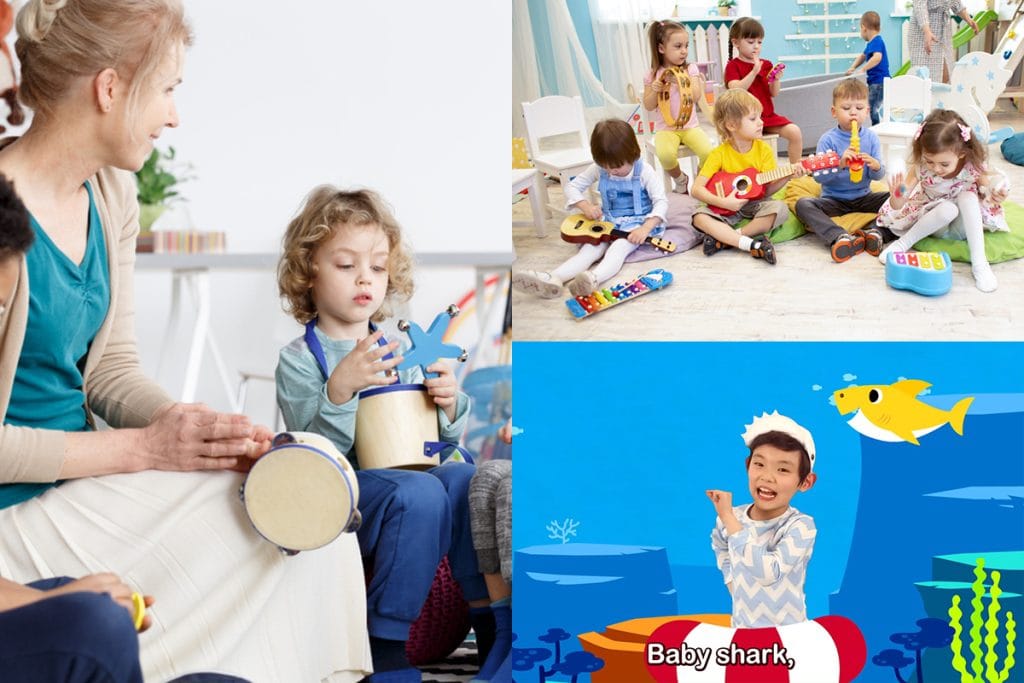
The benefits of an education in music are well-known. Being introduced to music early can greatly aid in your child’s development, well into the future.
If you are an educator of preschoolers, then you probably know this already. Which is why you’re looking for fun music activities for kindergarten.
Well, you’re in luck, because in this guide, you will find dozens of worthwhile music activity ideas you can bring to the classroom.
Musical Chairs
One of the oldest tricks in the book, the game of musical chairs teaches children how to discern the difference between sound and silence. It’s fun and educational!
Musical chairs can be a little too chaotic for a large group, and very uninteresting for a small group. It should be played with at least four to five players but use your discretion when playing musical chairs with larger groups.
How To Play Musical Chairs
To play musical chairs, you will first need to prepare music, which can be played on a CD player or your smartphone. You will also need to prepare one chair for every player, to be placed around the room (typically in a circle in the middle of the room).
While the music is playing, the children are to dance around the chairs or freely dance around the room. While this is happening, it will be your job as a teacher to remove one chair.
Stop the music as you see fit. Children are to find a chair the moment the music goes silent, as quickly as possible.
Whoever doesn’t manage to snag a chair is “out.”
And then it’s simply a matter of repeating. Put the music on, let the kindergartners dance about, remove another chair, stop the music, and let the children find a seat. Whoever doesn’t get a seat is “out.”
Those who are on the outside of the game can still dance or clap along assuming they are not otherwise interfering with the activity.
Musical Statues
Musical statues is a game very similar to musical chairs, with the main difference being that you do not require chairs to play it.
In a situation when you do not have sufficient chairs or need a safer alternative to a game of musical chairs, musical statues can do the trick. Children generally find it equally fun.
How To Play Musical Statues
The only thing you will need to prepare for a game of musical statues is music – either a CD player or a smartphone. It’s not a bad idea to ensure that the environment is safe for children to dance around in as well, though (clear away sharp objects, tripping hazards, toys with sharp ends, etc.).
When you’re ready to begin, play the music and let everyone dance around the room. Stop the music every now and then. As the rules have it, players must “freeze” when the music stops, or they are “out” of the game.
It’s an easy enough game that most players may not go “out,” but it’s a fun enough activity that children can play for a long time without getting bored. So, if you want to keep it going for a while, more power to you.
Pass The Parcel
Pass The Parcel is another familiar variation on activities already introduced. Where musical chairs or musical statues might require players to move about, however, “pass the parcel” is mostly about moving the parcel between the players while remaining seated.
If the players think too hard about it, the game isn’t any fun because the confused will tend to hold on to the parcel (especially if it’s a gift) without passing it around as they are supposed to (what’s the point of the game?).
So, be sure to explain how the activity works and why the parcel is being passed around! Otherwise, smarter children might take advantage or not want to play.
While “Pass the Parcel” can be played in a pair, it is a lot more fun if there are at least six people playing, and it’s usually not a problem to play the game in a larger group either.
How To Play Pass The Parcel
Prepare a “parcel.” If it is a birthday party, it can be a gift. Even if it’s not a party, it should still be a “prize” of some kind. Wrap it in a few layers of wrapping paper or newspaper. Ensure that the paper is easy to remove.
Play music on a smartphone or CD player. Get participants to pass the parcel around in a clockwise direction (it can’t hurt to get the children to sit in a circle!).
Stop the music. Let the person holding the parcel remove one layer of wrapping. Keep the game going until the final layer of wrapping is removed. The person to take the final layer off gets to keep the prize.
If you want to keep the game going, then change direction (anti-clockwise). Watch to ensure the parcel is passed with both hands and received with both hands. This is an activity that may require active supervision to work.
One Little Elephant (Balancing Song)
One Little Elephant is like walking a tightrope except there are no consequences for falling!
The activity is a simple one because all it requires you to do is follow the lyrics to the song, “One Little Elephant” (find the video below).
This activity is best played with up to five people, as the lyrics generally don’t account for more, and the more people involved, the longer the piece of string you will likely require.
Of course, you can creatively adapt the activity however you see fit!
How To Play One Little Elephant
You’ll need to prepare a long piece of string and lay it on the floor in a straight line. You as the teacher, parent, or guardian should start the game – be the first elephant to walk the string as everyone is singing the lyrics together.
As the second verse begins, get a child to join you for the second verse, another for the third verse, another for the fourth verse, and so on.
After the final verse, everyone gets to collapse on the floor (for fun – no need to hurt yourself!).
Repeat the game as desired.
How Many Instruments Do You Hear?

Before attempting this activity, it’s well worth taking some time to teach your kindergarteners about the many types of instruments that exist, especially the main ones – piano, guitar, bass, drums, violin, saxophone, and so on.
You can play this game without any real instruments in the room, but it does make for a better learning experience when you or someone else is playing them (could you ask a local band or maybe a keyboardist to come and join your class?).
This game can typically be played with any number of people.
How To Play How Many Instruments Do You Hear?
Play a song – play it yourself, bring in a band to play it, use a CD player, or take advantage of your smartphone (optionally with Bluetooth speakers).
While you can use just about any song for this activity, finding instrumental versions of the songs you’re planning to use is not a bad idea.
Also note that many modern songs only have synthesizers and drum machines in them, so guessing the instruments in Top 40 music probably won’t be much fun.
As the song is playing, the children should be instructed to draw the instruments they hear on a piece of paper.
Once the song is over, everyone can share their drawings and how many instruments they heard.
You don’t need to limit yourself to one song – you can repeat this activity as desired.
Match The Sounds
There are no right or wrong answers with Match the Sounds – only creative answers! With this activity, children are given the opportunity to pick out instruments that complement the music they’re hearing.
While you don’t require a larger group to play Match the Sounds, it is simple enough to adapt to more participants.
How To Play Match The Sounds
Prepare some basic instruments (or makeshift instruments) like spoons, boxes, triangles, tambourines, bells, etc. Play each instrument for the children. Then, play a song and have the children listen to the music to pick out which instrument “matches the sound” best.
Again, there are no right or wrong answers, and you can let your participants share why they picked the instrument they did.
Draw The Music
Here’s another activity where there’s plenty of freedom of expression. There’s no right way to “draw the music,” you can simply encourage your little participants to draw what they hear, whether it’s how the music makes them feel, waveforms (a concept you could teach), or even beats.
This is another activity that’s adaptable to smaller and larger groups of participants.
How To Play Draw The Music
Prepare large pieces of paper, pencils, crayons, and any other stationery that would be appropriate for the activity. Play a song, have the children listen, and then have them interpret what they hear on the paper. It’s okay to play the song multiple times as the children complete their drawings.
You don’t need to offer much guidance as to how to interpret the music, but you could create your own drawing as the children are making theirs and compare each other’s when done. This can be a fun activity of discovery.
Hide And Listen
In this activity, children get to use sound as a cue to find a hidden object in the room. It’s a little like hide and seek or Marco Polo.
Note that only one child at a time can realistically play Hide and Listen, especially if you want to keep things safe. That said, you can play as many rounds as you wish.
How To Play Hide And Listen
Prepare a blindfold. Put the blindfold on the child that’s playing and hide an object somewhere in the room. The object could be an instrument, like a tambourine, ukulele, or drum, but it doesn’t have to be.
Tell the child what object they are to find. Once you start playing the music, they can begin searching for the object. Play the music louder as they get closer and play the music softer as they get further from the object (explain this system to them in advance).
Keep guiding them until they find the object or cut them off after a few minutes if they are unable to find it (it’s up to you).
Dance To The Song
We all know that dancing is fun and energizing. And children love to dance to show their joy and express themselves freely. Dance to the Song is a free-form activity (practically an excuse for a spontaneous dance party!).
This is also an activity you can do no matter the number of participants (unless we’re talking about an unreasonable number of participants!).
How To Play Dance To The Song
If you wish, before you put a song on and start dancing, prepare props, like sticks, boxes, scarves, streamers, bells, or anything else you can think of that might be fun to bring to the party.
Put on a song and encourage the children to express themselves. Or get them to follow your moves – stomp feet, clap hands, snap fingers, march, walk on your tiptoes, and so on. Take advantage of the props for added expression.
Experiment with different types of child-friendly songs, be it pop, rock, classical, nursery rhymes, or otherwise.
If you wish, you can even choreograph an entire song and teach your children how the moves go.
Make Up A New Song
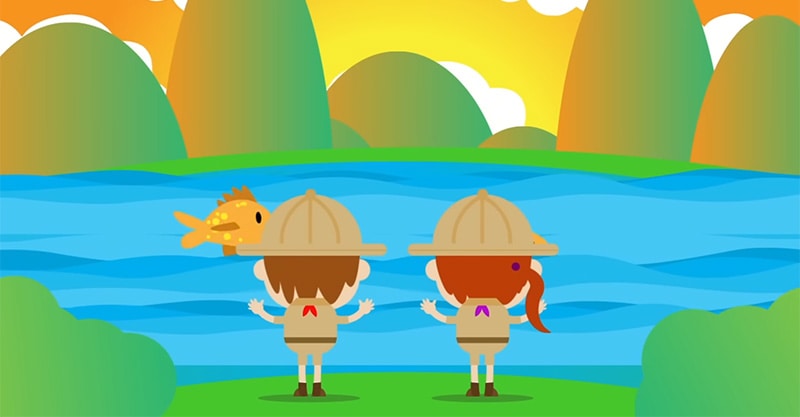
Speaking of activities that allow for creative expression, Make Up A New Song can be just the challenge your kindergartners need to uplevel their rhythmic and rhyming abilities.
You don’t need to worry too much about the number of participants in this activity, again, unless we’re talking about a huge number of children.
How To Play Make Up A New Song
Take a nursery rhyme like “Twinkle, Twinkle, Little Star” with a simple rhyming scheme and work with your participants to come up with a completely new song idea. Ensure that the verses rhyme like in the original and try to have the lyrics match the original’s rhythm (syllables) too. Of course, you can keep the original song’s melody!
Be The Conductor
Many children gravitate to the role of the conductor of an orchestra. If you don’t believe me, show them a video of a conductor in action and watch their reactions. Watch how they mimic the conductor. See what questions they ask you.
Be The Conductor is the perfect activity to have children experience what it’s like to direct a group of musicians.
Although any number of children can play this game simultaneously, you may need to teach each of them the movements you want to be performed.
How To Play Be The Conductor
There’s no one right way to play this game. The idea is to have a child play the role of an orchestra conductor.
You can supply her with a pencil or stick of some kind to make her really feel like a conductor. Have her listen to a song in its entirety, noticing where the song starts, where it stops, and where it gets louder or quieter.
Then, create actions for each of these. Left could be “start,” right could be “stop,” up could be “louder,” and down could be quieter.
Ideally, you should find a song with some fun dynamics so there are more motions for your little conductor(s) to perform.
Name The Rhythm
Name The Rhythm is a great game to pick for long trips in the car, on the bus, or even on the airplane (although I haven’t heard of kindergarten field trips involving an airplane…).
No game is going to keep anyone fully occupied for a long trip, but for a brief distraction, this one can work.
Of course, you can do this activity wherever and whenever, and there’s no reason you can’t play with a larger number of participants.
How To Play Name The Rhythm
Start out by chanting and clapping out the syllables of familiar names or words. You could, for example, chant and clap out the name of your pets, friends, or family members.
Once the activity is underway and the children see how it works, you can have the participants take turns clapping the syllables of names of their choosing (without chanting). Then everyone can take a guess at the name that’s being clapped out.
You can play for points or play for fun, either way works!
Jump The Hoop
The perfect activity for burning off some extra energy, Jump the Hoop is a fun game for your kindergartners to participate in.
Note – if you want to do this activity with multiple children, then you may need to prepare multiple hula hoops.
How To Play Jump The Hoop
Prepare a hula hoop and some music. Get the participant (or participants) to jump to the rhythm of a song. You can try any song of your choosing, though we hear the “Theme from Mission: Impossible” can yield some rather interesting results.
Start A Band
Children will get excited about just about any idea you’re excited about as a teacher. So, if you present the idea of “starting a band” in your classroom with enthusiasm, chances are the children will get excited and want to participate, even if they have no idea what it means!
Chances are you should be able to find a role for just about all of the children in your classroom.
How To Play Start A Band
There is no need to over-complicate this activity. Prepare some small / simple musical instruments children can play. If you don’t have any, make some during arts and crafts time, or procure some pots, pans, milk cartons, tissue boxes, or whatever else you can find at home for the occasion.
See if you can find an instrument for all the children. Then, see if you can teach them a song to play together. It probably won’t sound much like a real song, but you can at least get a rhythm going.
This is sure to be a ton of fun for the children!
Name The Song
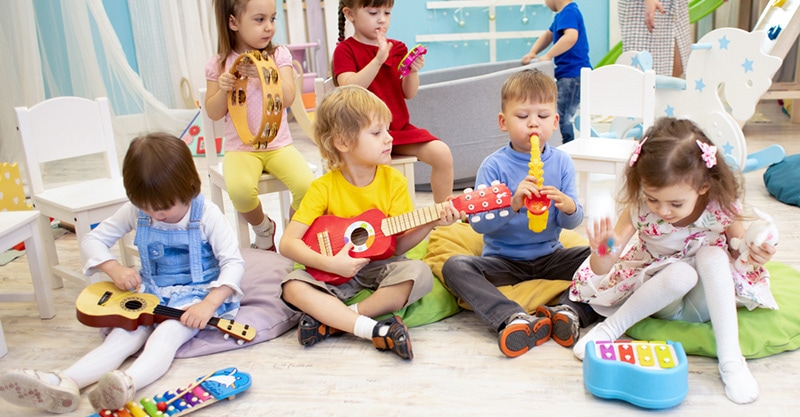
Do those adorable little kindergartners of yours have favorite songs and nursery rhymes? Of course, they do, especially if you’ve been playing songs for them on the regular.
Well, here’s a fun guessing game you can facilitate.
While you can probably only clap out the rhythm of one song at a time, you can certainly play this game with multiple participants.
How To Play Name The Song
Clap the rhythm to the participant’s favorite song or nursery rhyme and let them guess what the song is. If you’d like, you can make the activity more challenging by only clapping out a few beats of the song as opposed to the entire song or an entire section.
If the children need a little extra help, you could always mouth the lyrics!
Follow The Beat
This fun but simple activity can teach a child the difference between different beats and rhythms.
This activity is very similar to others we’ve already looked at, except that it has a stronger emphasis on tapping into a rhythm.
You can easily play this game with a larger group of children.
How To Play Follow The Beat
Prepare several songs, preferably those with differing beats or tempos.
Dance along to the songs and let the children join in. Encourage them to express themselves differently based on the beat or tempo of the song.
Make A Xylophone
If it’s time for more of a sit-down activity, then “Make a Xylophone” might be just what the doctor ordered.
You might not think it, but there are plenty of opportunities to incorporate musical activities into arts and crafts time.
While you can enjoy this activity with multiple children, you may only want one at a time playing with the makeshift xylophone.
How To Play Make A Xylophone
Prepare an array of glasses, jugs, or both. Fill all containers with varying levels of water. Order the containers from least full to most full.
Give the child a wooden spoon (or something else that can be used as a soft mallet – you don’t want to shatter the glasses) and have them experiment with tapping the rims of the glasses. Have them notice the difference in sounds the containers produce when filled with different measures of water.
Follow The Dance Leader
Sometimes the simple activities are the best ones. While they might require some energy on your part, they most certainly help those little ones burn off excess energy too.
This is another fun activity you can easily do with larger groups, if necessary.
How To Play Follow The Dance Leader
Make someone the dance leader. It might make sense for you as the teacher to start. Put on some music and perform some moves. Have the children follow your moves. Then, have the children take turns being the dance leader and have everyone follow their moves.
You might consider trying songs like:
- “Hokey Pokey”
- “The Chicken Dance”
- “Row, Row, Row Your Boat”
- “Itsy Bitsy Spider”
- “Head, Shoulders, Knees and Toes”
- “The Wheels on the Bus”
- “Shake Your Sillies Out”
- “Happy”
Animal Dance
Children love animals. And anything they love; they tend to learn fast. Here’s an opportunity to combine one of their favorite subjects (animals) with one of their favorite activities – dancing to music, of course!
You don’t need to worry too much about group size with this activity.
How To Play Animal Dance
There isn’t much to this one!
Prepare some fun music. It can be jungle themed if you like (but it doesn’t have to be).
Have the children dance like their favorite animals – lions, goats, elephants, rhinos, pandas, dogs, cats, giraffes, bears, kangaroos, and so on.
Get goofy and have fun.
Compose Music
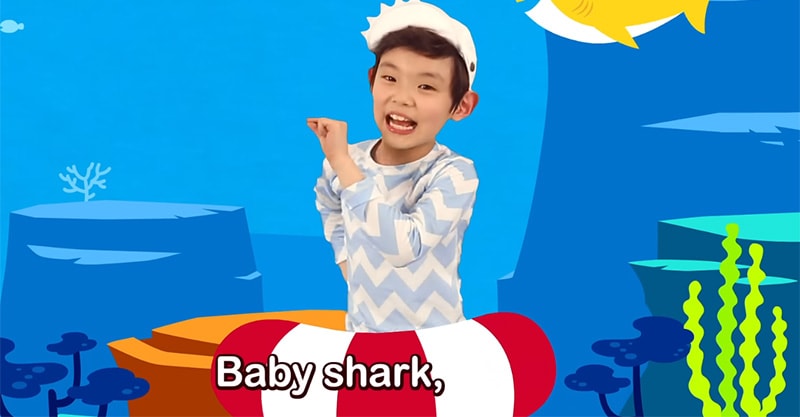
Composing music with kindergartners might seem like a daunting task, but they are up for the challenge if you keep it simple and fun.
This is another great sit-down activity, and the number of participants doesn’t matter too much. It’s mostly in the execution!
How To Play Compose Music
Prepare some paper and pencils or crayons. Introduce the children to the idea of creating symbols to represent different actions – for example, an X for a foot stomp, an O for a clap, or a + for a tambourine hit.
Once you’ve had the children create a few sequences with preset legends, let them create their own. Offer some suggestions if they’re stuck.
Of course, it could be worth having children perform their unique compositions as well.
This could fast become a favorite activity!
Limbo
The great thing about kindergartners is you usually don’t need to have the most sophisticated ideas to have some fun. Limbo is an activity even adults enjoy, so there’s a good chance this activity can take up a good chunk of time in a day.
Big groups aren’t a problem with this activity!
How To Play Limbo
Prepare a rope or a long stick and have two people hold either end (you’ll probably end up being one of those people). The idea is for children to bend over backward and pass under the rope without touching it.
Start high, and gradually bring the rope or stick down to make it harder to pass under. Those who end up touching the rope are “out.”
There are two ways to incorporate music and/or rhythm into a game of limbo:
- Play any song (or playlist) during the activity! Most upbeat tunes work nicely.
- Have the children clap as they’re watching their peers attempt to pass under the rope.
Hot Potato
The case could certainly be made that “Hot Potato” and “Pass the Parcel” are the same thing. But in the absence of gifts or prizes, Hot Potato is probably a simpler, more workable option.
How To Play Hot Potato
Prepare a beanbag or another object that’s relatively soft and easy to pass around (maybe a tennis ball?). Have the children sit in a big circle. As the music plays, have them pass the beanbag to each other, as quickly as possible, as though it were a hot potato.
Choose your moment and stop the music. Whoever is holding the object when the music stops moves outside of the circle. Those who are “out” can still participate by clapping or dancing to the music.
Karaoke
Children love music. And they love singing their favorite songs too. If you think your classroom might be ready for just such a challenge, it might be worth throwing a karaoke party.
How To Play Karaoke
Prepare instrumentals of your children’s favorite songs or nursery rhymes. Let them take turns singing their favorite songs.
Nowadays, you can find fun toy microphones on Amazon. Of course, in the absence of a sound system or proper mic, you can always make a makeshift microphone during arts and crafts time and have the precious little ones sing into that.
Drum Circle
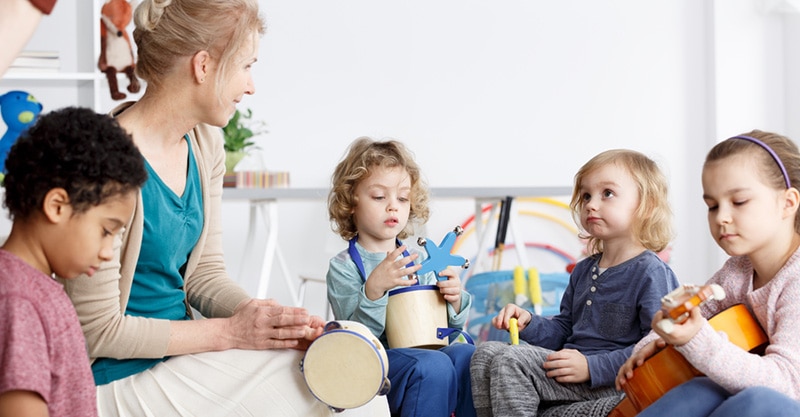
Rhythm is at the foundation of music. It provides the beat or the groove. And there are a lot of fun activities you can create around rhythm, including a Drum Circle.
How To Play Drum Circle
Prepare an array of percussive “instruments” – drumsticks, cardboard boxes, maracas, shakers, tambourines, and the like.
Act as the leader of the drum circle and pound out a simple beat. Instruct the children to play the same rhythm as you. As things get going, play a new rhythm, and again, have the children follow you.
Then, let the rhythm naturally evolve. A drum circle is an activity where everyone brings something to the beat.
Note – drum circles do tend to get a little noisy.
Bear Hunt
And now, it’s time for something scary. Just kidding! There’s a good chance your preschoolers already know a thing or two about the song “We’re Going on a Bear Hunt,” and if they don’t, they’ll probably be delighted to learn!
See below:
How To Play Bear Hunt
Maybe I’m out of the loop, but I don’t think there’s a “right” way to play this game. You can simply put the song on, have the children sing along, and follow the actions in the song / video.
Bear Hunt will probably become a fast favorite in your classroom.
Baby Shark Dance
Love it or hate it, “Baby Shark” went viral in November 2015 and remains a part of mainstream consciousness. It’s to the point where it has spawned plenty of spinoffs and parodies.
How To Play Baby Shark Dance
The only thing you need to prepare for Baby Shark Dance is the above video (just the audio will do fine if you know the actions). Learning the song and actions that go with it should not take your preschoolers any time at all.
Musical Clothes
Here’s yet another variation on musical chairs / hot potato that can be a lot of goofy fun.
How To Play Musical Clothes
You’ll need to prepare a bag full of silly and/or unusual clothing – things like wigs, rubber noses, whacky hats, silly glasses, you get the idea.
Arrange the chairs in a circle and prepare a bit of music. Play the music and have the children pass the bag of clothes around in a clockwise direction. Press pause on the music when you see fit, and whoever is holding the bag must take a piece of clothing out of the bag and put it on.
Repeat until the bag is empty. Whoever has the whackiest costume at the end is the winner.
Top Music Activities For Kindergarten, Final Thoughts
It’s okay to experiment and try different things. Some activities work for some children, others don’t. It’s okay to switch things up, or even adapt certain activities to suit your needs.
We hope you found everything you were looking for and maybe even a little more. Best of luck with those kindergartners.